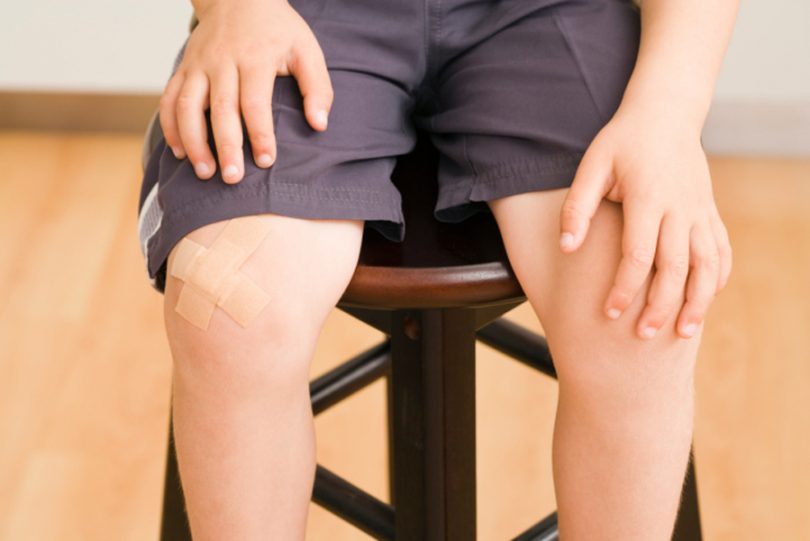Written by Steven G. Reece, M.D.
Recognizing knee pain and treating the issue the right way are important for health at any age.
Baseball, lacrosse, track and field, tennis, soccer—just a few of the spring sports offerings at local schools. How about runners, bikers or swimmers, or guys like me trying to stay on the fitness radar and looking forward to being more active outside? Are our knees ready? What kinds of injuries do we, and our kids, need to be on the lookout for? Let’s walk through some spring-sport-specific injuries for the student athlete, as well as look at some common knee injury patterns and treatments for the active adult.
Are kids just “little adults”?
So often we see parents bring their child in for an office visit to get his or her knee evaluated so a quick return to a sport—the “Got a game tonight, Doc” bit—is possible. Many times these are multi-sport/multi-team kids accustomed to playing year-round; and as they hit their pubescent growth spurt, their knees begin to ache and limit their performance.
Kids, of course, are growing, and those growth centers are particularly susceptible to injuries, especially in the face of intense activity levels. Where an adult might get tendinitis, kids often suffer from inflammation where major tendons attach to bones, or the apophysis, a secondary growth center, and thus require more rest.
Osgood Schlatter’s disease and Sinding Larsen Johansson disease are two common examples of such issues. Osgood Schlatter’s involves the secondary growth center where the patella tendon inserts into the tibia, whereas Sinding Larsen Johansson involves the distal patella where the patellar tendon originates. Both involve inflammation on the front of the knee in the presence of high activity and growth. For girls, this is most often seen in ages 9 to 11; boys mature later, and can expect the same problems between 11 and 14 years of age. Although these conditions are painful, they are self-limiting and will go away on their own if given enough time and rest. Our general recommendations are for the child to take it easy until he or she is no longer limping, use nonsteroidal anti-inflammatory drugs (NSAIDs) or Tylenol to control pain, ice the knee for 10 to 15 minutes after practices/games, and consider use of a patellar tendon strap to help relieve some of the tension.
As spring sports arrive, encourage kids to become more active if they have taken the winter off. Start slowly, and ramp up activity levels as tolerated. Be careful with pursuing more than one high-level activity; for instance, both recreational and school soccer might be too much for the growing 12-year-old. If you or your child’s coach notices the child is limping or other unusual behaviors related to the knee, have the kid pulled out of practice/play and initiate care. Should that knee continue to cause trouble over the next few days despite rest, ice and NSAIDs, have either your primary care provider or sports medicine doctor take a peek to rule out other possibile health issues.
How about Mom and Dad’s fitness plan?
While the sports may not involve team uniforms, adults can also pick up a higher activity level, and perhaps suffer because of it. Delayed New Year’s resolutions, ramping up for that spring 10K, dusting off that home fitness video, hitting the Zumba dance floor—all represent a potential marked change in baseline activity level, and thus pose the potential for knee pain related to overuse.
The most common overuse knee issue we see in our sports medicine center is patellofemoral pain. This often presents as anterior knee pain (though posterior knee pain and medial/lateral symptoms can be involved as well), most often with increased activity levels. The pain seems worse with prolonged periods of sitting in a deep knee flexed position or with walking down stairs or declining slopes. It is often described as an aching sensation after activity and can be associated with faint popping sounds when going up and down the stairs.
After an exam, we often learn these folks have poor quadricep strength or knee caps that track laterally rather than centrally in the trochlea, the valley where the knee cap lives. Women may have malalignment at the knee where the hip/knee cap/patella tendon relationship is not lined up properly, thus contributing to the problem. The knee is not unstable—and usually is not swollen significantly—but is painful when the knee cap is stressed.
The typical recommendations are NSAIDs to help control symptoms; ice after activity; and wearing a brace to help with patella tracking until, through physical therapy, adequate strength is developed in the quad muscle that controls patella movement. Often, the iliotibial (IT) band
is tight on the outside of the knee
and needs to be addressed to increase its flexibility.
Another important part of the treatment involves evaluating the patient’s gait, as well as a thorough review of his or her training program. Patellofemoral pain can often be traced back to speed work or recently added hill training.
With the right treatment and training modification, a patient should be able to overcome patellofemoral pain and attack their spring fitness goals head-on. Be smart, patient and willing to cross-train—and, most importantly, get out there and enjoy being active.


